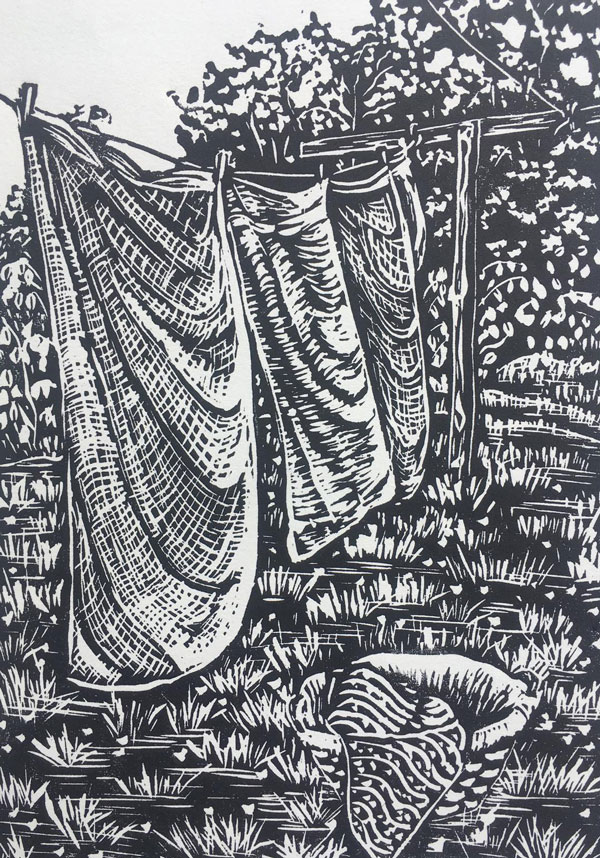
By Michele “Mike” Ochonicky
Healthy Planet Arts Editor
photo caption: “Warsh Day”, by Deby Gilley; linocut print; at Art St. Louis
Two seemingly unrelated ARTS items, with dates that bookend August, arrived in my inbox as I prepared to write my column for this issue. But together they proved indeed timely. They informed my approach to this month’s ARTS.
I normally do not cover television programming, however…
When I heard about Show Me the Music: A Celebration of the Missouri Bicentennial, presented by The Sheldon, the event seemed perfect to showcase Missouri’s musical talents during our 200th year of statehood. Filmed live at The Sheldon in front of a limited capacity audience in May, musicians from throughout Missouri represent musical genres from blues and ragtime to jazz, R&B and classical. The list is impressive, from bluegrass superstar Rhonda Vincent and her band The Rage, jazz pianist Peter Martin, R&B vocalist Anita Jackson, ragtime pianist Royce Martin, to a newly commissioned classical work by composer Stefan Freund. It airs on Nine PBS, August 9 at 7 p.m. Encore broadcasts include August 10, 11, and 14. Plus, educational materials for K-12 grade teachers are available at www.thesheldon.org/showmeeducation .
So, I thought about music’s place in history, not just Missouri, but throughout the country…
Then, on exhibition August 30-September 30 is Mound City Chronicle at the Contemporary Gallery of St. Louis Community College, Forest Park campus (5600 Oakland). These photographs by Jason Gray present the vanishing parts of St. Louis, once known as “Mound City.” Said Gray, “The process of removing and replacing, of what is removed and what is replaces is…what I have focused on for the last decade, through a journey that includes lost-and-found subterranean lakes and caves, sites removed from public view (due to security, secrecy, or both), crumbling buildings in ruin or stately grace, and the people encountered, vibrant and varied.”
So, I though about change, recent and ages ago…
How does ART relate to history, to our past? How will that past inform our future? As we emerge from COVID-19 isolation, we now ponder what is gone, what has been removed, what is replaced. As a society, and as individuals, we are now examining how we are changed since early 2020. How will history books record this time? What do we miss? What is gone forever? What now represents us, after living through the pandemic?
The International Photography Hall of Fame and Museum, 3415 Olive, presents Camera Work: Pictorialism and Photogravure, through October 16. The exhibition features classic works from over 20 artists including Alfred Stieglitz, Edward Steichen, Julia Margaret Cameron and many more. Highlighted are portraits, landscapes and illustrations contained in editions of Camera Work journal, from 1905-1913. One image, entitled “The Steerage” by Alfred Steiglitz is a haunting look at immigrants from a century ago. More at www.iphf.org.
Ordinary Lives at Art St. Louis is a multi-media exhibition of works focused on seemingly ordinary things that make everyday meaningful. Multi-media juried works by 42 artists address one’s inner, private life of domesticity, observing how ordinary lives are actually extraordinary. With an opening reception on August 7 from 5-7 p.m. at 1223 Pine Street, the exhibition continues through September 9. Details at www.artstlouis.org.
From July 2-Sept. 6, the Sheldon Art Galleries, 3846 Washington, present 3 exhibitions by two artists. ArtConfident: Seek But You May Not Find presents paintings by Kailyn Hill. She investigates the construction of identity with an exploration into various forms of self-expression and personal adornment. Hill traces Black American cultural aesthetics to understand the connection between traditional African adornment and contemporary expressions of style and identity.
Mark Appling Fisher presents his works in the other two exhibitons at The Sheldon. Through a Glass, Darkly combines Fisher’s own contemporary work with photographs created on 19th century glass plates. He addresses climate change and the increasing effects on the planet. Floods, fire, erosion, air and water pollution, chemicals, and carbon dioxide emissions are referenced in his works.
Top Shelf Eyes is a series of photographs by Fisher of carnival chalk figurines from the early- to mid-20th century. Eerie and simultaneously amusing, the images speak of carnival entertainments for generations past. More info at www.thesheldon.org .
Flags designate significant sites or represent cultural and national identity. They communicate complex ideas with minimal information. Premiering on August 7 (through December 19), Laumeier Sculpture Park at 12580 Rott Road presents the first in its annual flag series, commissioning contemporary artists to imagine a flag representative of the time, playful or thought-provoking. Pittsburgh-based artist Kim Beck designed this first flag, entitled Here, in the park’s Northern Grove. More info at www.laumeier.org.


